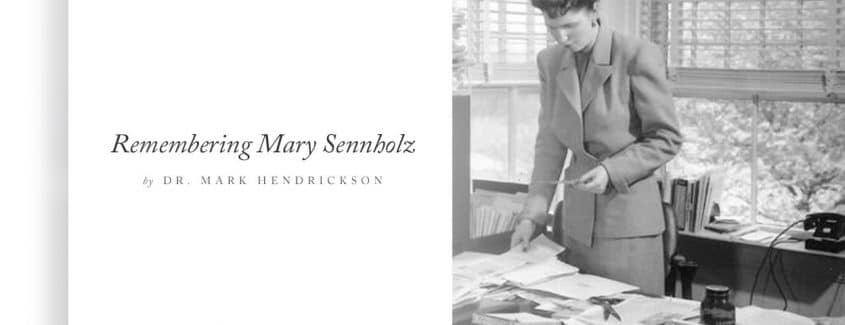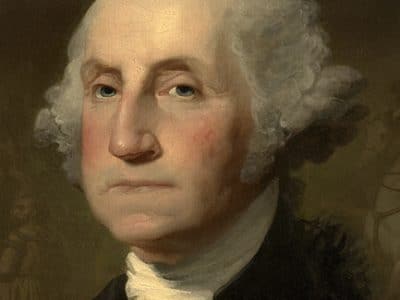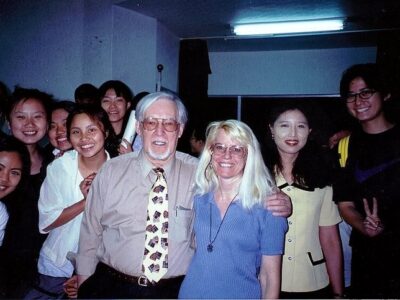
Mary Sennholz—a Grove City College legend and the widow of another GCC legend—passed away peacefully in her sleep early Sunday morning. She was 103, she was ready, and she did it her way: She never moved into a nursing home, but lived out her days in the longtime Sennholz home on Pine Street, a block away from the college softball field.
Her passing evokes a flood of powerful memories. She was a special lady, important both to Grove City College and to me personally. I’ll tell you about her significance to GCC first, and then you can decide whether to read the personal anecdotes.
As time relentlessly moves on, the collective memories of giants in the institutional history of Grove City College inexorably fade into the ever-receding mists of the past. The end of Mary Sennholz’s earthly sojourn sunders our strongest link to the Hans Sennholz era. Hans—perhaps GCC’s most famous professor of the 20th century—was chairman of the department of economics from 1955 to 1991, teaching thousands of GCC students about the wonders of free markets while educating thousands of others by lecturing internationally and writing prolifically. It was ten years ago this very month that Hans left this world, and now his beloved partner in life and in work has joined him.
In addition to the obvious connection to Hans, Mary also served as one of the college’s principal surviving ties to J. Howard Pew, whose four decades as chairman of the board of GCC greatly shaped the college that the current generation has inherited. The ties between Mary and Pew were more than incidental, more than simply being a matter of having known each other for 16 years. It was J. Howard Pew who handpicked Hans Sennholz to come to Grove City with his bride and young son to singlehandedly reverse the slide toward pernicious collectivist errors that distorted and obscured economic truth.
It was Mr. Pew who had the vision to discern that in Hans Sennholz he had found a rare man with the courage, commitment, and scholarly excellence to spark a revival. How ironic that it took a foreigner to remind Americans of the central role that economic liberty played in our country’s emergence as the freest and most prosperous place in the history of mankind. (Don’t ever underestimate the courage that Hans needed. When he started teaching freedom instead of statism, leftist members of the GCC faculty riled up students to the point that they would “buzz” the Sennholz house, speeding their cars down the alley next to it and forcing Hans and Mary to keep their little boy inside for his safety.)
There is more to the relationship of Mary Sennholz and J. Howard Pew: Not only did Mr. Pew change Mary’s life and the college’s profile by bringing the Sennholzes to Grove City, but Mary ultimately became Pew’s biographer. She memorialized him in a book, Faith and Freedom: A Biographical Sketch of a Great American: J. Howard Pew, published in 1975, four years after the great man’s death. This was, by the way, one of four books that Mary authored.
Another way in which Mary Sennholz became a fixture in the GCC community was the tradition of Christmas parties at the Sennholz house. Generations of GCC students and faculty partook of holiday cheer there—a tradition that continued after Hans’ passing and through Mary turning 100. At those parties, Mary reigned supreme, leading the guests in the singing of Christmas carols by playing the piano while Hans took care of the details such as welcoming guests and keeping the punch bowl filled. Mary was a virtuoso at the piano, playing an enormous catalog of melodies without the use of printed scores, just as Hans always lectured without written notes.
For my personal memories of Mary, I hardly know where to begin. I knew her since 1980 when I came to Grove City specifically to study economics with Hans. After meeting my wife and settling here, the friendship between our families was ongoing. My wife, daughter, and I hosted and were guests of the Sennholzes many times over the years, including staying in the hotel they owned in Spring Mills, Pennsylvania near the farm where Mary grew up. She and my daughter (a GCC graduate who co-majored in piano) would take turns playing when Mary was at our house. When my own mother passed in 1994, I gave Mary a little bell that I had given Mom when I was seven, because at that time Mary had a bell collection.
Ten Junes ago, I was visiting relatives in Montana when my wife called to tell me that Mary wanted to talk with me. I immediately phoned her. Hans had passed, and she asked if I would return home early “so we can all be together.” I gladly did so, returning in time for the funeral.
In her last 10 years, I visited Mary every few months. We talked about God, life, death, how she missed Hans, our kids (and her grandkids), etc. She wasn’t sure for what purpose she was lingering on earth. When she turned 100, I urged her to write her fifth book and call it “My First Hundred Years.” She liked the title, but just wasn’t interested, even though the content would have been fascinating. She worked for Presidents Franklin Roosevelt and Harry Truman. After that, she worked at the Foundation for Economic Education (FEE). She and Hans met the Reagans, at which time the future president told Hans that he had been plagiarizing Hans’ material for years whereupon Hans (never a shrinking violet) replied, “You’re plagiarizing good stuff!” She worked for decades as a proofreader for Hans’ writings, and after he retired from Grove City College in 1991, the Sennholzes—both in their 70s by then—worked day and night for five years to reorganize and revitalize FEE. How amazing it was to see this refined lady washing floors and painting walls at age 78. Mary even had the greatest economist of the 20th century, Ludwig von Mises, as her son’s godfather.
I suppose this was quite natural, since Mrs. Mises had arranged the original meeting between Hans and Mary.
In spite of not wanting to be an author again, Mary by no means became a recluse. She always attended faculty dinners at the college, right up through last December, even playing the piano for several hundred diners a couple of years ago. My wife loved it when I escorted my centenarian lady friend to college events, such as the Hans Sennholz Memorial Lecture in Austrian Economics or the annual scholarship dinner where the recipient of the Hans Sennholz Memorial Scholarship was honored.
Mary experienced multiple physical challenges, but she never lost her mental clarity. She told me on several occasions that people would find out her age and say, “Oh, you’re 103—how wonderful!” to which she would wryly reply, “You think so? Try it sometime—you might change your mind.”
In February, Mary suffered a stroke that made it difficult for her to talk. I visited her nine days before she passed. It was clear that I was saying “goodbye.” She was receiving hospice care. I got close to Mary’s ear and recited a couple of lines from that old Welsh hymn: “Through the love of God our Saviour, all will be well.” Music was always Mary’s favorite language, and she indeed had a strong faith that God would set things right sooner or later. Her beloved daughter-in-law and I talked while I held Mary’s hand for about a half hour. She couldn’t talk with her mouth, but the firm and purposeful grip of her hand let me know that she appreciated a last visit from a long-time friend.
Now Mary has moved on from this world. She would most like to be remembered as a woman who loved her Lord, a devoted wife, a loving mother and grandmother, and a patriotic American. She also will be remembered as one of the all-time grand ladies of Grove City College.
Thank you for being such a dear friend, Mary.




